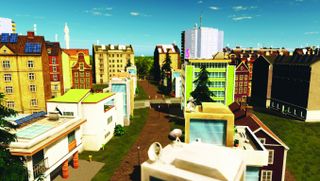How Cities: Skylines is being used to build a real-life city district
Reach for the Skylines.

Norra Djurgårdstaden is an area in central Stockholm that’s currently undergoing substantial urban redevelopment. The Swedish Building Service, Svensk Byggtjänst, has partnered with city officials and, with a focus on long-term sustainability, the on-going initiative plans to add 12,000 new homes and 35,000 workspaces to the region in a bid to offset its ever-increasing population. How does this relate to the world of videogames? City-building simulator Cities: Skylinesis at the forefront of the project.
By simulating real-life environments and scenarios in-game, Paradox and Colossal Order’s city-builder is being used by real-world city planners to explore ways to support the needs of the new district’s residents. “Norra Djurgårdstaden is seeking new ways of engaging people that are normally not involved in the discussions of the future of our city, and how to plan for its desired direction,” says project director Staffan Lorentz. “Games can be an entry port for a new group having a real say and having new ways of looking at things.”

That’s where Cities: Skylines comes in. By way of three weekend-long workshops, Stockholm city officials have joined Swedish Building Service representatives, Paradox and Colossal Order developers, and members of the public to discuss how the proposed district will look and function once development is complete. Special considerations such as environmental schemes to reduce fossil fuel consumption and the installation of surplus cycle lanes and public transport routes have been flagged as top priority, thus these scenarios have been applied and tested in-game to see how they might play out in reality.
As such, the district in its entirety has been mapped out both via a scaled physical model and within Cities: Skylines—with city planners applying and reapplying digital iterations of the area following visits to and from the real-world building site itself. Without prior training, technical blueprints mean very little to the average citizen. Therefore the point of the coinciding workshops is to showcase the scheme in earnest—fully realised in three dimensions against relatable surroundings—which in turn serves to help the learning process.
“I think the most exciting part about all of this is that it isn’t just a PR stunt,” says Paradox’s COO Susana Meza. “Actually, people are genuinely wanting to solve some of the problems and issues that might arise when city planning in this day and age, but also innovate around it. The fact they have the people who’re are actually making the decisions, sitting on the budget, involved in this and using a new medium I think is extremely cool—but also brave.”


Learn how Chris got on with Cities: Skylines' latest Natural Disasters expansion.
Using games as a public consultation tool is something the Swedish Building Service is already familiar with, having collaborated with Mojang and the United Nations in 2012. Named Block By Block, this project was a similar city-building scheme that used Minecraft to encourage fresh perspectives and helped citizens have a say in the reconstruction process of their own neighbourhoods. The Norra Djurgårdstaden project, on the other hand, operates on a grander scale and therefore marks a more sophisticated collaboration between city development and videogames.
Yet Cities: Skylines in its vanilla state isn’t without its limitations, and to this end renowned Cities modder Alexander Oberroither was flown in from Austria to attend the last workshop. Here, he explained how the game might better portray reality with the use of additional user-made mods beyond the base game. “I see potential in Cities: Skylines being used for a lot of different things in real life, and this workshop fulfilled its purpose in allowing us to find out which direction the project is going,” says Oberroither. “I really enjoyed my three days [taking part]. I learned a lot and I hope that I can make use of it when I start studying spatial planning at the university in October.”
PC Gamer Newsletter
Sign up to get the best content of the week, and great gaming deals, as picked by the editors.
In light of the most recent workshop, the Swedish Building Service plans to review its findings and decide how Cities: Skylines can best be used in pushing the project forward. When the time comes, no matter how close the game’s interpretation is to the project’s final incarnation, the ways in which Cities: Skylines has been used to help visualise proposals, discuss city functions, and, ultimately, design buildings is quite remarkable and is something which could pave the way for similar ventures down the line.

“I think that today most people have an association with games, be that yourself or your kids playing with them, most people are exposed to games in one way or another,” adds Meza. “As such, it’s a super powerful medium to do something more beyond providing entertainment. I think we’ve just scraped the surface. Games are something everyone is talking about now—we have every possibility to make an impact.”
In the case of Norra Djurgårdstaden, its residents are the ones who’ll be impacted the most. “Engaging citizens is part of the future,” says Norra Djurgårdstaden local Ann Edberg. “It’s fantastic to be able to participate in the creation of a new part of Stockholm during its development process, rather than just experience it once it’s done.”
Photos for this feature by Pelle Jansson/Cowmob Photography.

Boasting economist lobstermen, gas mask aliens with 120 sexes, and the best space dogfights 2003 has to offer, Underspace is a sci-fi RPG well worth your time

Paradox apologizes for latest Cities: Skylines 2 boondoggle, will give refunds for the Beach Properties DLC: '[We] hope we can regain your trust going forward'
Most Popular


